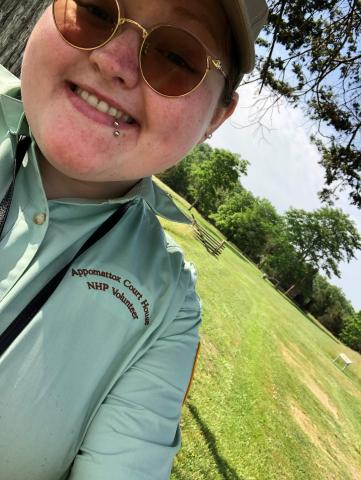
Appomattox Court House National Historical Park, surrounded by rolling green hills and dense foliage, was the ideal location for a second-year graduate student such as myself to spend her summer. This Nau Center internship provided the opportunity to work hands-on with the history of the surrender meeting between Generals Ulysses S. Grant and Robert E. Lee. By caring for the artifacts and documents associated with the meeting and the landscape on which it occurred, I helped to ensure their longevity for future generations. I worked with amazing staff members from a variety of backgrounds who happily shared career and education experiences with those of us still pondering our futures. Though the work itself was rewarding, the park staff were integral in making the experience worthwhile.
As the cultural resources intern, I spent the summer working with park curator Ann Roos on Mondays, Wednesdays, and Fridays, during which I was immersed in the application of preservation methods and museum studies. Alongside the park’s museum technician, I completed a variety of housekeeping measures on the park’s historic buildings. This included dusting, vacuuming, and conducting environmental data maintenance. Though this may seem like a mundane task, dust is detrimental to artifacts, as it causes abrasion and attracts critters.
Collecting environmental data was one of my favorite parts of the summer. I conducted light readings of the historic spaces where artifacts were housed, using a device that provides a numerical reading of the UV rays and illuminance subjected to the artifacts. To assist in monitoring the conditions of the artifacts, each historic space has a device that records the room’s temperature and humidity. Unstable weather conditions cause deterioration of the artifacts, and it is important to be as in control of these conditions as possible. When conducting light readings, we inserted a USB drive into the device to transfer the data to the USB. In addition, another kind of data collection plays into this aspect of museum housekeeping. That is, pest collection and analysis. At the beginning of every month, museum staff sets sticky traps in the historic buildings to collect common museum pests. Staff members place a small cage over the open sides of the trap to prevent mice, lizards, and snakes from entering, though sometimes they still manage to find their way in. After collecting the traps each month, we looked at them to determine what kind of bugs were present in the spaces and whether an infestation was occurring.
On Tuesdays and Thursdays, I helped park historian Patrick Schroeder transcribe a variety of primary source materials. These included Civil War diaries written by soldiers present at Appomattox in April 1865 as well as 20th-century articles commemorating the surrender. During this aspect of the internship, Schroder asked me to write a small article for the Appomattox Court House National Historical Park newsletter about Abram B. Lawrence, who came into possession of the pens used during the Commissioners’ Meeting the day after the surrender. It was an interesting task, as I discovered that Lawrence claimed the pens to be the ones used in penning the surrender agreement between Lee and Grant on April 9th, but they were actually the ones used to pen the commissioners’ agreement on April 10th, which hashed out details of the surrender terms. I was also tasked with conducting research on more than 217 soldiers present at the surrender, during which I collected available images of them and of their gravestones.
Overall, the Appomattox Court House National Historical Park internship provided a wonderful opportunity to be on the ground at a historic site learning how to care for historical objects and buildings. The National Park Service and its employees continue to work tirelessly to maintain the park for future generations, and this is exemplified by the daily interactions I had with the staff. There was always someone willing to answer my questions and entertain my various historical tangents. Though I am surrounded by historically passionate individuals at UVA, there was something profound about having these conversations on the grounds on which they happened. I hope to continue expanding the skills I learned while at the park in addition to maintaining my connections with the National Park Service as I hope to one day join their ranks.
